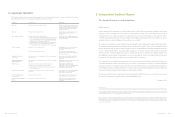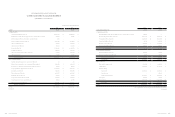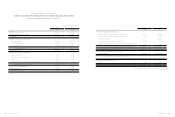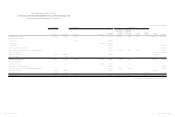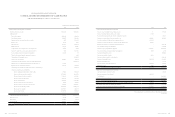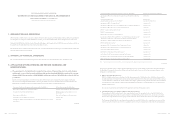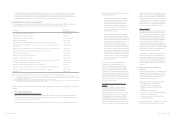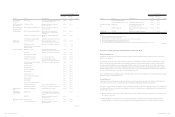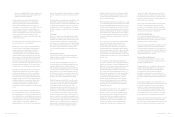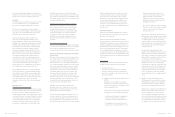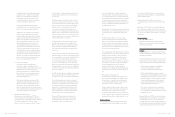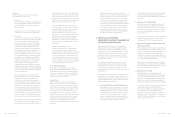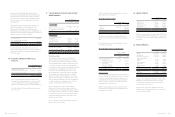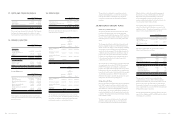HTC 2014 Annual Report Download - page 123
Download and view the complete annual report
Please find page 123 of the 2014 HTC annual report below. You can navigate through the pages in the report by either clicking on the pages listed below, or by using the keyword search tool below to find specific information within the annual report.
• Financial information Financial information •
242 243
item of property, plant and equipment is determined as
the difference between the sales proceeds and the carrying
amount of the asset and is recognized in profit or loss.
Goodwill
Goodwill arising on an acquisition of a business is carried
at cost as established at the date of acquisition of the
business less accumulated impairment losses, if any.
For the purposes of impairment testing, goodwill is
allocated to each of the Company’s cash-generating units
(or groups of cash-generating units) that is expected to
benefit from the synergies of the combination.
A cash-generating unit to which goodwill has been
allocated is tested for impairment annually, or more
frequently when there is an indication that the unit may
be impaired, by comparing its carrying amount, including
the attributable goodwill, with its recoverable amount.
However, if the goodwill allocated to a cash-generating
unit was acquired in a business combination during
the current annual period, that unit shall be tested for
impairment before the end of the current annual period.
If the recoverable amount of the cash-generating unit
is less than its carrying amount, the impairment loss
is allocated first to reduce the carrying amount of any
goodwill allocated to the unit and then to the other assets
of the unit pro rata based on the carrying amount of each
asset in the unit. Any impairment loss is recognized
directly in profit or loss. An impairment loss recognized
for goodwill is not reversed in subsequent periods.
If goodwill has been allocated to a cash-generating unit
and the entity disposes of an operation within that unit,
the goodwill associated with the operation disposed of is
included in the carrying amount of the operation when
determining the gain or loss on disposal, and is measured
on the basis of the relative values of the operation
disposed of and the portion of the cash-generating unit
retained.
Intangible Assets
Intangible assets acquired separately
Intangible assets with finite useful lives that are acquired
separately are initially measured at cost and subsequently
measured at cost less accumulated amortization and
accumulated impairment loss. Amortization is recognized
on a straight-line basis. The estimated useful life, residual
value, and amortization method are reviewed at the end
of each reporting period, with the effect of any changes
in estimate accounted for on a prospective basis. The
residual value of an intangible asset with a finite useful
life shall be assumed to be zero unless the Company
expects to dispose of the intangible asset before the end of
its economic life. Intangible assets with indefinite useful
lives that are acquired separately are measured at cost less
accumulated impairment loss.
Intangible assets acquired in a business combination
Intangible assets acquired in a business combination
and recognized separately from goodwill are initially
recognized at their fair value at the acquisition date
(which is regarded as their cost). Subsequent to initial
recognition, intangible assets acquired in a business
combination are reported at cost less accumulated
amortization and accumulated impairment losses, on
the same basis as intangible assets that are acquired
separately.
Derecognition of intangible assets
Gains or losses arising from derecognition of an intangible
asset, measured as the difference between the net disposal
proceeds and the carrying amount of the asset, are
recognized in profit or loss when the asset is derecognized.
Impairment of Tangible and Intangible Assets Other
Than Goodwill
At the end of each reporting period, the Company reviews
the carrying amounts of its tangible and intangible assets,
excluding goodwill, to determine whether there is any
indication that those assets have suffered an impairment
loss. If any such indication exists, the recoverable amount
of the asset is estimated in order to determine the extent
of the impairment loss, if any. When it is not possible to
estimate the recoverable amount of an individual asset,
the Company estimates the recoverable amount of the
cash-generating unit to which the asset belongs. When
a reasonable and consistent basis of allocation can be
identified, corporate assets are also allocated to individual
cash-generating units, or otherwise they are allocated to
the smallest group of cash-generating units for which a
reasonable and consistent allocation basis.
Intangible assets with indefinite useful lives and
intangible assets not yet available for use are tested for
impairment at least annually, and whenever there is an
indication that the asset may be impaired.
Recoverable amount is the higher of fair value less costs
to sell and value in use. If the recoverable amount of an
asset or cash-generating unit is estimated to be less than
its carrying amount, the carrying amount of the asset or
cash-generating unit is reduced to its recoverable amount.
When an impairment loss subsequently is reversed, the
carrying amount of the asset or a cash-generating unit
is increased to the revised estimate of its recoverable
amount, but so that the increased carrying amount does
not exceed the carrying amount that would have been
determined had no impairment loss been recognized
for the asset (or cash-generating unit) in prior years. A
reversal of an impairment loss is recognized immediately
in profit or loss.
Financial Instruments
Financial assets and financial liabilities are recognized
when a group entity becomes a party to the contractual
provisions of the instruments.
Financial assets and financial liabilities are initially
measured at fair value. Transaction costs that are directly
attributable to the acquisition or issue of financial assets
and financial liabilities (other than financial assets and
financial liabilities at fair value through profit or loss) are
added to or deducted from the fair value of the financial
assets or financial liabilities, as appropriate, on initial
recognition. Transaction costs directly attributable to the
acquisition of financial assets or financial liabilities at fair
value through profit or loss are recognized immediately in
profit or loss.
Financial assets
All regular way purchases or sales of financial assets are
recognized and derecognized on a trade date basis.
a. Measurement category
Financial assets are classified into the following
categories: Financial assets at fair value through
profit or loss, available-for-sale financial assets, and
loans and receivables.
1) Financial assets at fair value through profit or loss
(FVTPL)
Financial assets are classified as at fair value
through profit or loss when the financial asset is
either held for trading or it is designated as at fair
value through profit or loss.
A financial asset may be designated as at fair value
through profit or loss upon initial recognition if:
• Such designation eliminates or significantly
reduces a measurement or recognition
inconsistency that would otherwise arise; or
• The financial asset forms part of a group of
financial assets or financial liabilities or both,
which is managed and its performance is
evaluated on a fair value basis, in accordance
with the Company’s documented risk
management or investment strategy, and
information about the grouping is provided
internally on that basis; or
• The contract contains one or more embedded
derivatives so that the entire hybrid (combined)
contract can be designated as at fair value
through profit or loss.
Financial assets at FVTPL are stated at fair value,
with any gains or losses arising on remeasurement
recognized in profit or loss. The net gain or loss
recognized in profit or loss incorporates any
dividend or interest earned on the financial asset
and is included in the ‘other gains and losses’ line
item. Fair value is determined in the manner
described in Note 29.
Investments in equity instruments under
financial assets at FVTPL that do not have a listed
market price in an active market and whose fair
value cannot be reliably measured and derivatives
that are linked to and must be settled by delivery
of such unquoted equity instruments are
subsequently measured at cost less any identified
impairment loss at the end of each reporting
period and are recognized in a separate line item
as financial assets carried at cost. The financial
assets are remeasured at fair value if they can be
reliably measured at fair value in a subsequent
period. The difference between the carrying
amount and the fair value is recognized in profit
or loss.
2) Available-for-sales (AFS) financial assets
AFS financial assets are non-derivatives that are
either designated as AFS or are not classified as
(i) loans and receivables, (ii) held-to-maturity
investments or (iii) financial assets at FVTPL.
Changes in the carrying amount of AFS monetary
financial assets relating to changes in foreign
currency exchange rates (see below), interest
income calculated using the effective interest
method and dividends on AFS equity investments
are recognized in profit or loss. Other changes in
the carrying amount of AFS financial assets are
recognized in other comprehensive income and


